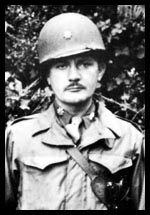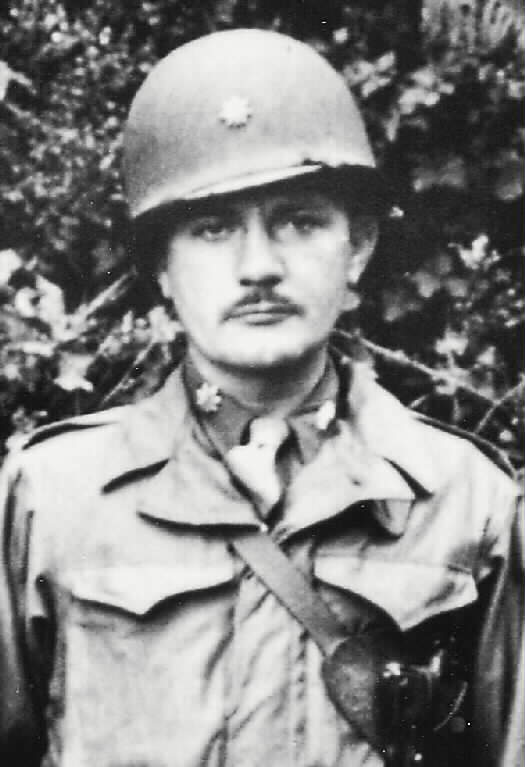Courtesy of the United States Military Academy:
WILLIAM L. HEROLD 1935
No. 10393 – 13 November 1912–20 August 1944. Died near Argentan, France
Interred in Arlington National Cemetery, Arlington, Virginia
It has been 54 years since an enemy artillery shell burst on the 610th Tank Destroyer battalion command group in France wounding all five, and the commander critically. Still, bright memories remain with all who knew him. At a recent battalion reunion in his honor, those present vividly recalled and admired him for his sterling character and superb leadership.
Born in Sutton, West Virginia, the son of Senator Anderson C. and Genevieve Lee Herold, William Lee was known as “Bill.” At an early age, he demonstrated an inquisitive, competitive spirit and a penchant for winning. Being an adaptable student, Bill breezed through the Sutton school system, played the trumpet, and was active in athletics as well as in the 4-H and Boy Scout programs. He was successful in raising and handling the grand championship in the 4-H State Livestock Roundup in 1927.
Bill liked to win and was a winner — a quality he never abandoned. He became interested in a military career and, in a typically aggressive manner, campaigned for an appointment to West Point by soliciting legislators on the steps of the Capitol in Washington, D.C. His perseverance was rewarded with an appointment from West Virginia, 6th District, by the Honorable Joseph Smith.
In addition to their trust, he had their affection. Where he led, they would follow.
Bill’s classmates immediately recognized an adventurous, energetic, aggressive competitor who could accomplish almost any task. His jovial nature attracted many friends throughout the Corps and his strong, exceptional voice won him a spot with the Cadet Chapel Choir.
While he had his bouts with the academic departments, in the end, Bill won. On graduation, he selected the Infantry. Bill and Eleanor O’Rear of Waynesboro, Pennsylvania, married and went to their first station at Fort Moultrie, South Carolina.
Later, at Fort Clayton, Canal Zone, Bill, in addition to other assignments, served as aide de-camp to Generals Lear, Frederick Smith and Jarman; all of whom contributed to his rapidly developing command leadership. The highlights of this tour were the births of Ann Logan in 1937 and William Lee II in 1939.
After three years in Panama, Bill attended the Student Tank Course at the Infantry School, Fort Benning, Georgia. He learned about tanks’ capabilities and vulnerabilities, lessons used in his next assignment with the newly formed anti-tank units at Fort Meade, Maryland. With the mission of developing the organization and tactics of this new arm, Bill and his newly designated Tank Destroyer Battalion went to Fort Hood. Now a major serving as S-3, Advanced Unit Training Center, he wrote the tactical portion of the TD Field Manual, FM 18-5.
Promoted in November 1942, he took command of the 610th TD Battalion at Fort Hood. Bill brought all his former training, experience, and leadership to this demanding position. His forthright, demanding, and courageous ways were tempered with a bit of humor and an understanding of human nature. His inspiring leadership was immediately apparent. The battalion began setting records in athletics and other fields, including the Army Unit Test scores and weapons firing. Bill’s leadership permeated the entire battalion. It was his habit to reward exceptional accomplishments by individuals and units. For the outstanding showing on the Army Unit Tests, he took the battalion on a three-day holiday at Longhorn State Park, Texas.
Assigned to Camp Atterbury, the battalion again performed with distinction during the Tennessee maneuvers. He arranged for a dance to be held at Bowling Green, Kentucky, on an overnight stop returning to Atterbury. All were told to behave, which they did out of respect for their unit. In addition to their trust, he had their affection. Where he led, they would follow.
Orders came to convert to a towed 3″ gun battalion. No one had ever seen a 3″ gun. The shock was lessened when it was explained that a limited number of only the best units were to be converted, as time was short for organizing and training. Bill rallied his troops, gave specific instructions, and then went about seeing that the job was done. On 1 June 1944, completely prepared, the 610th TD Battalion sailed for Scotland.
After staging through England, Bill landed the battalion over Utah Beach on 31 July and, following several bombings and strafings a few days later, joined the 80th Division in the attack to close the Argentan-Falaise Pocket. During the advance, one of Bill’s admonishments was to the battalion surgeon, who quoted him as saying, “Doc, I want you to keep a good record of all the boys in our outfit who are killed, because when the war is over, I am personally going to visit each man’s family and tell them what a hero their son was.” He was denied the fulfillment of this promise.
Just east of Argentan, a small stream held up the advance. To expedite the crossing, Bill organized the building of a ford using nearby fencing materials. While thus engaged, enemy artillery fire targeted the forward command group and all five were wounded. Bill died the next day. He was awarded the Silver Star and Purple Heart for his last action in the service of his country. Bill’s remains were returned from France in 1949 to Arlington National Cemetery to rest in peace among many comrades-in-arms.
A book entitled The 610th Tank Destroyer Battalion – April 10, 1942–December 7, 1945 was written by Major Roy T. McGrann, the battalion intelligence officer. Mrs. Herold composed the “Tank Destroyer March.” Frank Malone of SMU orchestrated it. It was played at candidate graduation exercises and SMU football games. Surviving are his widow Eleanor, daughter Ann, son William, brothers Anderson and James, and sister Phoebe Phelps.
We salute Bill Herold, who won all but the last one, who lived the highest ideals of West Point and to whom we are most grateful. Well done.
Family, friends, and classmates
Michael Robert Patterson was born in Arlington and is the son of a former officer of the US Army. So it was no wonder that sooner or later his interests drew him to American history and especially to American military history. Many of his articles can be found on renowned portals like the New York Times, Washingtonpost or Wikipedia.
Reviewed by: Michael Howard


